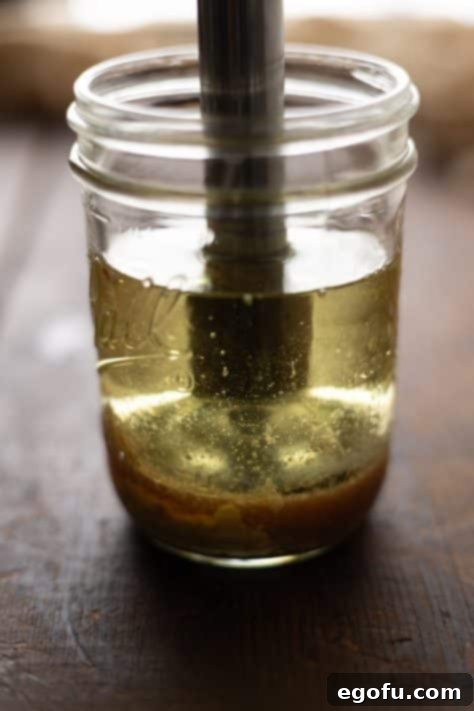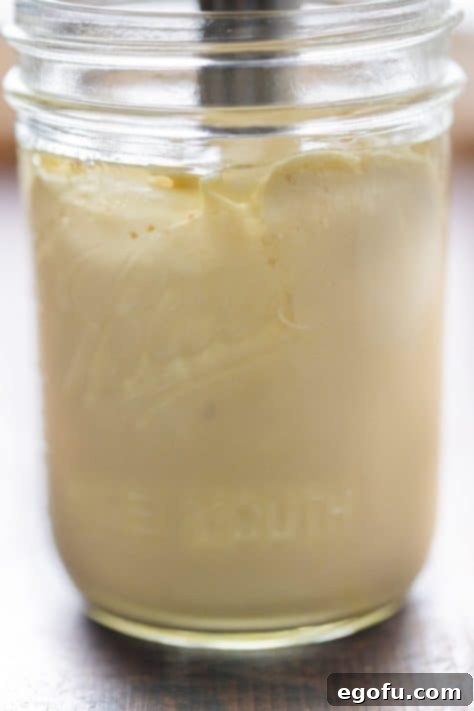Unlock a world of fresh, vibrant flavor with your very own homemade mayonnaise! Forget the store-bought versions filled with preservatives and unfamiliar ingredients. In just five minutes, using a handful of common pantry staples, you can whip up a batch of rich, creamy, and undeniably delicious mayonnaise that will elevate every dish it touches. This isn’t just a condiment; it’s a game-changer for your culinary adventures, offering unparalleled freshness and a taste you’ll crave.
Mastering Homemade Mayonnaise: Your 5-Minute Guide to Creamy Perfection
There’s a unique satisfaction that comes from creating staples in your own kitchen, and mayonnaise is no exception. This simple yet profound recipe empowers you to take control of your ingredients, ensuring a healthier and more flavorful result. Once you experience the superior taste and velvety texture of freshly made mayo, you’ll wonder why you ever settled for anything less. It’s incredibly versatile, perfect for sandwiches, dressings, dips, and everything in between. The process is so straightforward, you’ll never have to worry about running out again.

Why Choose Homemade Mayonnaise Over Store-Bought?
The decision to make your own mayonnaise is a step towards healthier, tastier eating. Store-bought mayonnaise often contains artificial preservatives, stabilizers, and high-fructose corn syrup, all of which detract from both flavor and nutritional value. When you make mayonnaise at home, you control every single ingredient. This means you can opt for high-quality, fresh eggs, select your preferred healthy oils, and adjust the seasoning to perfectly match your palate.
Beyond health benefits, the flavor of homemade mayonnaise is simply incomparable. It’s brighter, fresher, and lacks the sometimes overwhelming tang or artificial undertones found in commercial brands. Furthermore, it’s surprisingly cost-effective. The core ingredients—eggs, oil, and an acid—are inexpensive pantry staples, making this a budget-friendly way to enjoy a gourmet-quality condiment. The ability to customize your mayonnaise with different oils, mustards, or even a hint of garlic or herbs opens up a world of culinary possibilities that pre-made options simply can’t offer.

Easy to make and so much better than the store bought stuff! – Brenda
Frequently Asked Questions: Your Comprehensive Homemade Mayonnaise Troubleshooting Guide
Embarking on your mayonnaise-making journey can sometimes come with questions. Don’t worry, we’ve got you covered with answers to the most common queries and troubleshooting tips to ensure your homemade mayo turns out perfectly every time.
If your mayonnaise is thinner than desired, it likely needs more oil to achieve the correct emulsion. The key is to add oil very slowly while continuously blending. For a quick fix, add another tablespoon or two of the same oil you used, pouring it in a thin, steady stream directly into the mixture while the immersion blender or food processor is running. Continue blending until the desired thick, creamy consistency is reached. Patience is crucial during this step; adding too much oil too quickly can cause the emulsion to break.
If your mayonnaise has become too thick, don’t despair! This is an easier fix than a thin mayo. Simply add a teaspoon of water (or a bit more lemon juice or vinegar for added flavor) at a time, blending thoroughly after each addition. Continue this process until the mayonnaise reaches your preferred spreadable consistency. Remember, you can always add more liquid, but you can’t easily take it out, so start with small amounts.
A “broken” mayonnaise appears curdled, with the oil separating from the egg and other ingredients. This usually happens if the oil was added too quickly, the ingredients were too cold, or the blending wasn’t continuous enough. To fix broken mayo, place one fresh egg yolk into a clean food processor or a tall container for an immersion blender. While processing or blending, very slowly drizzle the broken mayonnaise mixture into the fresh egg yolk. The new yolk will act as a fresh emulsifier, gradually reincorporating the separated oil and bringing your mayonnaise back to its creamy glory. This method also works by hand with vigorous whisking, but it requires considerable effort!
Absolutely! While an immersion blender makes the process incredibly fast and easy, a food processor is an excellent alternative. If using a food processor, it’s best to use the small bowl attachment, especially for a single batch. A larger bowl might not allow the ingredients to come together properly, as the volume might be too low for the blades to effectively emulsify. You can also make mayonnaise by hand using a whisk, but be prepared for an arm workout and ensure you add the oil incredibly slowly, drop by drop at first, to prevent it from breaking.
Since homemade mayonnaise contains raw eggs and no artificial preservatives, its shelf life is shorter than commercial varieties. When stored in an airtight container in the refrigerator, homemade mayonnaise will typically last for approximately two weeks. Always use a clean spoon or utensil to scoop it out to prevent contamination, and if you notice any off odors or discoloration, it’s best to discard it.
Freezing homemade mayonnaise is not recommended. The emulsified fat and water separate during the freezing and thawing process, causing the mayonnaise to “break” and become grainy, oily, and unappetizing. It will lose its creamy texture and likely be unusable for most applications. It’s best to enjoy homemade mayonnaise fresh and within its recommended refrigerated shelf life.
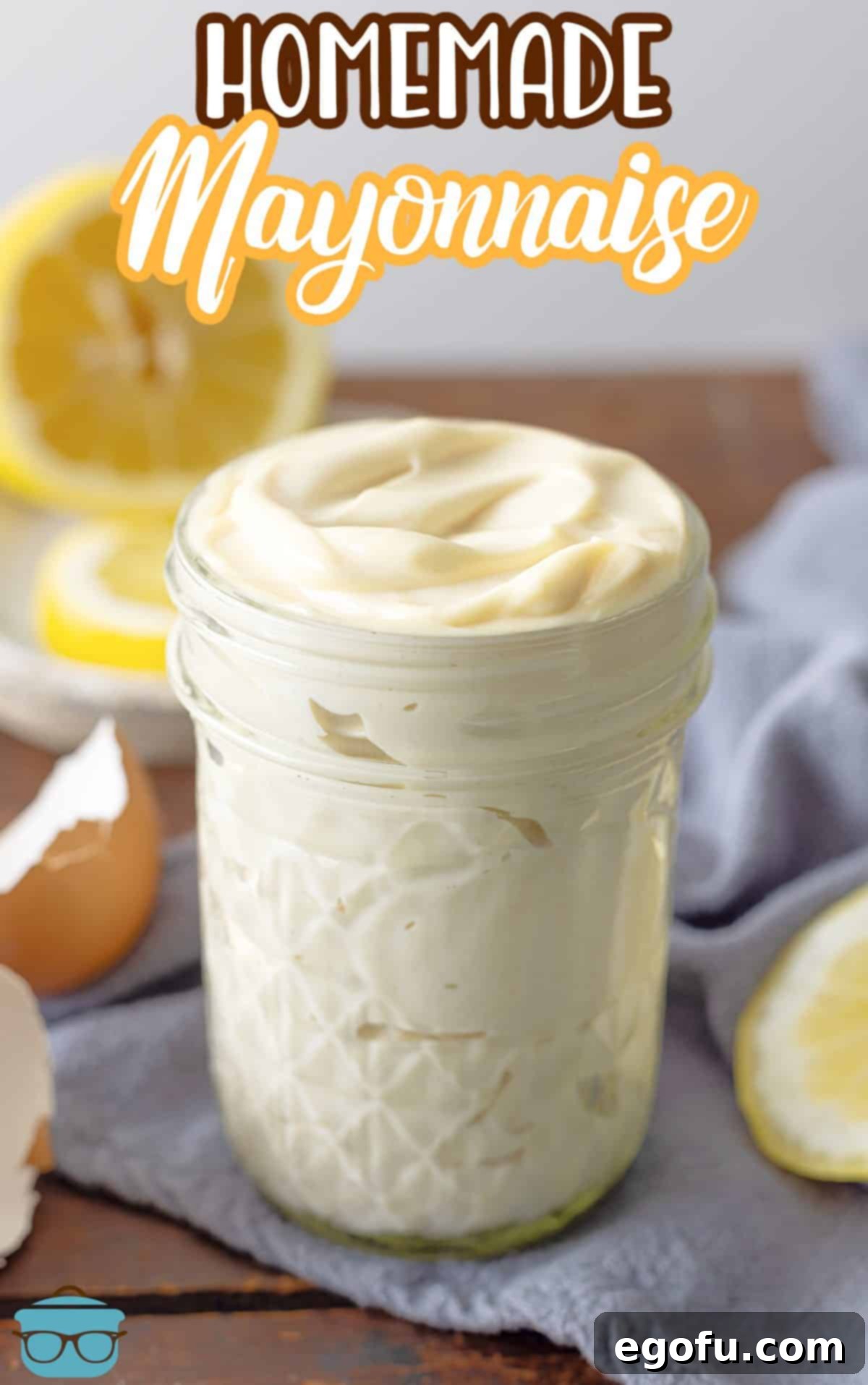
Essential Ingredients for Your Perfect Homemade Mayonnaise
Creating the perfect homemade mayonnaise starts with high-quality, fresh ingredients. Each component plays a crucial role in achieving that creamy texture and balanced flavor. Here’s a closer look at what you’ll need and why each ingredient matters:
- Large Egg: The cornerstone of mayonnaise, the egg yolk contains lecithin, a natural emulsifier that binds the oil and water components together. For safety, especially when consuming raw eggs, it’s highly recommended to use fresh, pasteurized eggs if available. Ensure your egg is at room temperature before starting; cold ingredients are a common culprit for a broken emulsion.
- Vegetable Oil: The bulk of your mayonnaise is oil, so choose wisely! Neutral-flavored oils like vegetable, canola, safflower, or sunflower oil are ideal as they provide a smooth base without overpowering the other flavors. While some enjoy the distinct taste of olive oil or avocado oil in their mayonnaise, be aware that their stronger flavors will be very prominent. Experiment to find what you prefer, but always use an oil you genuinely enjoy the taste of, as its flavor will be a dominant note in your final product.
- Dijon Mustard: More than just a flavor enhancer, Dijon mustard is a powerful secondary emulsifier. Its compounds help stabilize the emulsion, preventing the mayonnaise from breaking. It contributes a subtle, tangy depth of flavor without overtly tasting “mustardy.” We highly recommend Dijon over regular yellow mustard, as the latter tends to have a much stronger, sometimes artificial, flavor that can detract from the delicate balance of homemade mayo. While technically optional, it significantly improves both stability and taste.
- Red Wine Vinegar: Vinegar provides the essential acidity needed to balance the richness of the oil and egg, brightening the overall flavor. Red wine vinegar offers a lovely subtle fruitiness that complements the other ingredients beautifully. However, you can easily substitute it with white vinegar, apple cider vinegar, or even white wine vinegar if that’s what you have on hand. The key is to introduce a touch of tang.
- Fresh Lemon Juice: For that vibrant, citrusy “zing” that makes mayonnaise truly shine, fresh lemon juice is indispensable. Please, do not use bottled lemon juice! The artificial taste of bottled juice can ruin the fresh flavor profile of your homemade mayonnaise, imparting an unpleasantly chemical note. If fresh lemons are unavailable, you can increase the amount of vinegar slightly, but the unique brightness of fresh lemon juice is worth the effort.
- Salt: Salt is vital for seasoning and enhancing all the other flavors in your mayonnaise. While the initial recipe calls for a quarter teaspoon, you can adjust this to your personal preference. For those monitoring sodium intake, it can be reduced or omitted, but even a small amount makes a big difference in rounding out the overall taste without making the mayonnaise overtly salty. Fine sea salt or kosher salt are good choices.
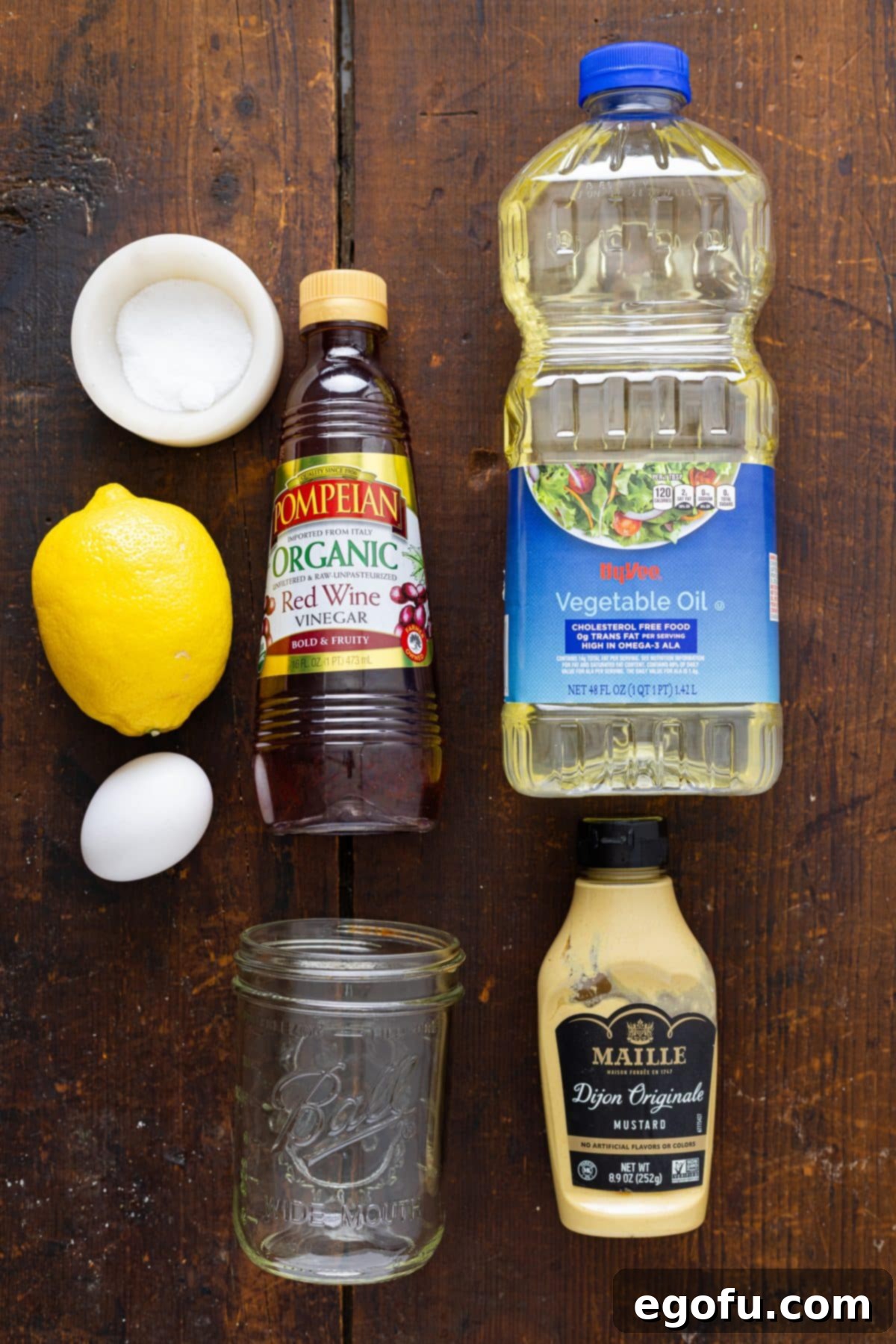
Step-by-Step Guide: Crafting Your Creamy Homemade Mayonnaise
Making homemade mayonnaise with an immersion blender is remarkably simple and fast. Follow these steps for a consistently creamy and delicious result:
Step 1: Gather and Combine Ingredients
Begin by adding all your ingredients—the large egg, vegetable oil, Dijon mustard, red wine vinegar, fresh lemon juice, and salt—into a wide-mouth pint-size mason jar. It’s crucial that all your ingredients, especially the egg and oil, are at room temperature. This significantly aids in proper emulsification, helping the oil and water-based ingredients to combine smoothly rather than separate.
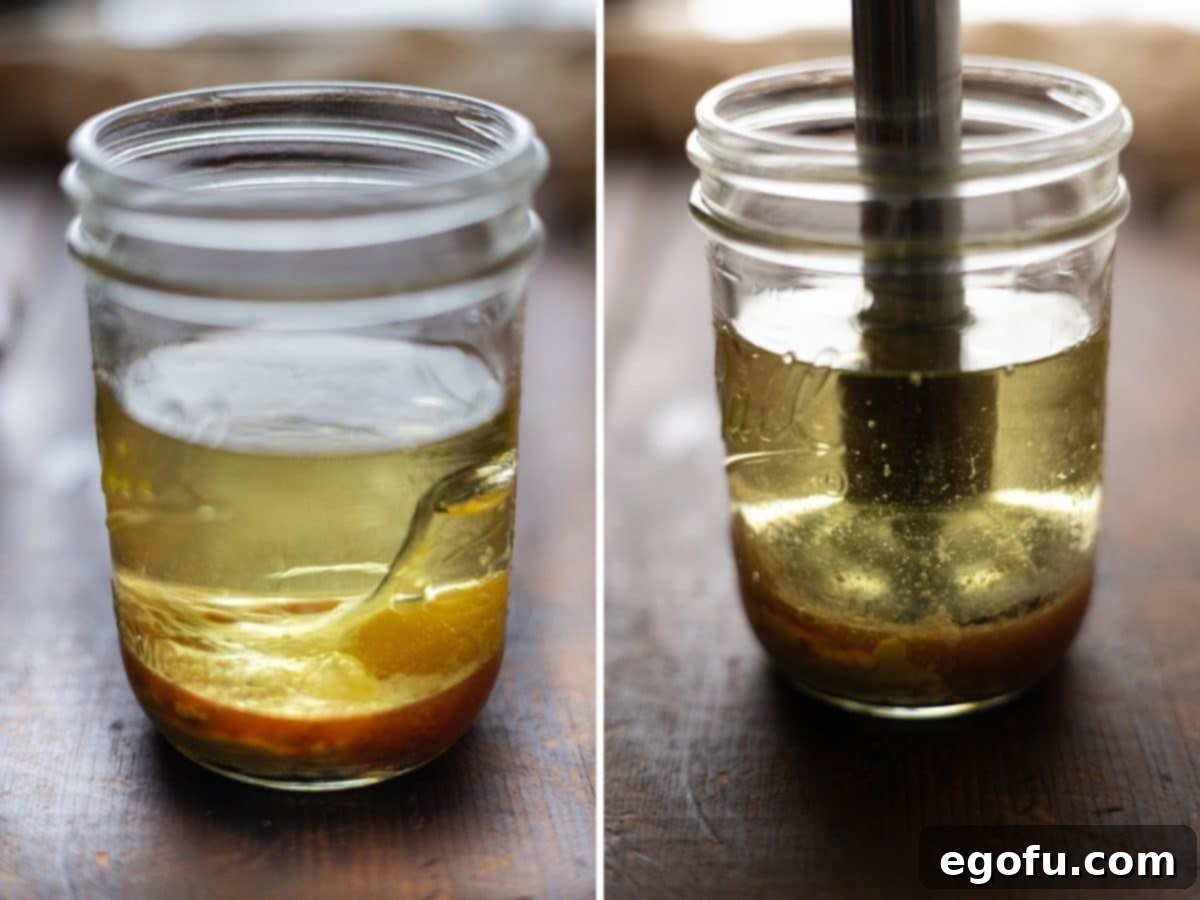
Step 2: Immerse and Blend to Perfection
Carefully insert your immersion blender to the very bottom of the jar, ensuring it fully covers the egg yolk. Begin blending on high speed without immediately moving the blender. Allow it to run for about 10-15 seconds, or until you see a thick, creamy emulsion starting to form at the bottom of the jar. This initial stationary blending is critical for kick-starting the emulsification process. Once the bottom layer is thick, slowly and steadily lift the immersion blender up through the mixture, gradually incorporating all the oil from the top. Continue to move the blender up and down gently until the entire mixture is uniformly thick, opaque, and creamy. This process typically takes only 1-2 minutes from start to finish.

Step 3: Taste and Adjust Seasoning
Once your mayonnaise has reached its desired creamy consistency, give it a taste test. This is your opportunity to customize the flavor profile. If you prefer a saltier taste, add a pinch more salt. For a brighter, tangier kick, squeeze in a little more fresh lemon juice. Blend briefly after each addition to ensure the new seasoning is thoroughly incorporated. Transfer your fresh homemade mayonnaise to a clean, airtight container and refrigerate immediately.
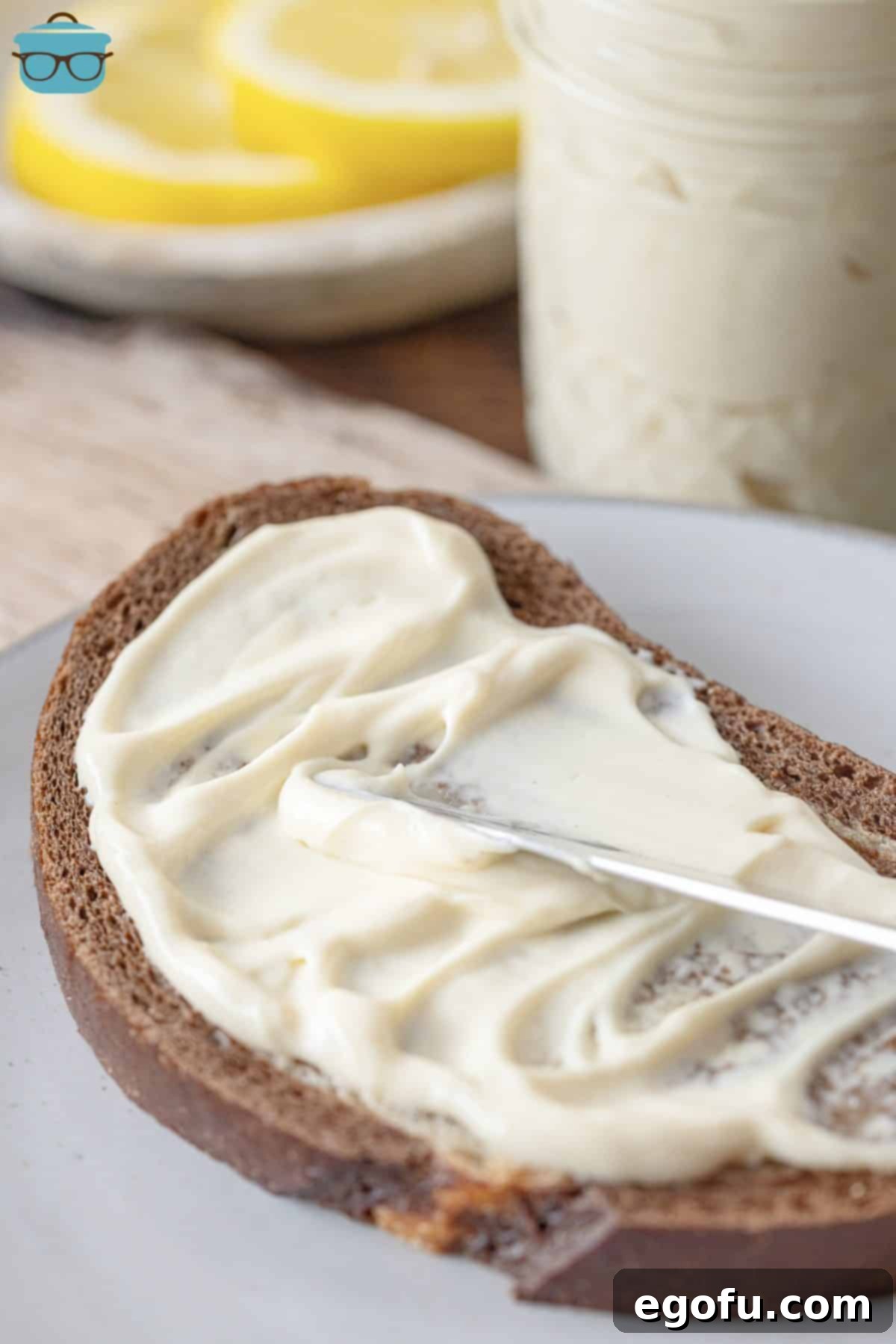
Creative Ways to Enjoy Your Versatile Homemade Mayonnaise
The beauty of homemade mayonnaise extends far beyond its delicious taste and simple preparation. Its versatility makes it an indispensable ingredient in countless recipes, allowing you to elevate everyday meals into something extraordinary. Here are just a few ideas to inspire you:
- Sandwiches & Wraps: Ditch the bland, store-bought spreads. A dollop of homemade mayo instantly transforms any sandwich or wrap, adding a luscious creaminess and fresh flavor that store-bought versions simply can’t replicate.
- Dressings & Dips: Homemade mayonnaise forms the perfect base for an array of delightful dressings and dips. Mix it with fresh herbs for a vibrant green goddess, add garlic and lemon for a quick aioli, or blend with sriracha for a spicy kick. It’s ideal for creating creamy salad dressings, vegetable dips, or a rich sauce for grilled meats.
- Potato Salad & Coleslaw: These classic side dishes truly sing when made with homemade mayonnaise. Its fresh flavor allows the other ingredients to shine, resulting in a side that tastes genuinely homemade and wholesome.
- Deviled Eggs: For the ultimate deviled eggs, homemade mayo is a must. Its superior texture and taste will make your deviled eggs the star of any potluck or gathering.
- Marinades: Incorporate mayonnaise into marinades for chicken or fish to tenderize and add flavor. The fat in the mayo helps keep proteins moist during cooking while infusing them with savory goodness.
- Baked Goods: Surprisingly, mayonnaise can be a secret ingredient in some baked goods, like chocolate cake, where its oil and egg content contribute to an incredibly moist crumb.
With its fresh taste and adaptable nature, your homemade mayonnaise is sure to become a cherished addition to your kitchen arsenal. Experiment with adding different spices, herbs, or even a dash of hot sauce to create your signature flavored mayo. The possibilities are truly endless!
Explore More Homemade Staples!
- Homemade Caesar Dressing
- Homemade Ranch Dressing
- Homemade Yum Yum Sauce
- Mayonnaise Salad Dressing
- Homemade BBQ Sauce
- Homemade Ranch Seasoning
- Homemade Everything But The Bagel Seasoning
- Homemade Apple Pie Spice
- Homemade Pumpkin Pie Spice
- Homemade Cream of Chicken Soup
- Homemade Cream of Mushroom Soup
- Homemade Nacho Cheese Sauce
- Beau Monde Seasoning
- Taco Seasoning
- Homemade Ranch Dressing
- Homemade Velveeta

Homemade Mayonnaise
Print
Pin
Rate
5 minutes
5 minutes
16
Brandie Skibinski
Ingredients
- 1 large egg
- 1 cup vegetable oil
- 1 Tablespoon Dijon Mustard
- 1 Tablespoon Red Wine Vinegar
- 1 teaspoon fresh lemon juice
- ¼ teaspoon salt
Instructions
- Add all ingredients to a wide mouth pint-size mason jar. Ensure all ingredients are at room temperature for optimal emulsification.

- Insert an immersion blender to the bottom of the jar. Blend without moving for 10-15 seconds until the emulsion begins. Then, slowly lift and lower the blender, allowing the oil to incorporate fully, until you achieve a thick, creamy consistency. This usually takes 1-2 minutes.

- Taste and adjust seasoning. Add more salt for balance or extra lemon juice for a brighter, tangier flavor, blending briefly after each addition.

Notes
- For more detailed information on troubleshooting or ingredient substitutions, please refer to the “Frequently Asked Questions” and “Essential Ingredients” sections above.
Condiments
American
Nutrition
|
Carbohydrates: 0.1g
|
Protein: 0.4g
|
Fat: 14g
|
Sodium: 51mg
|
Fiber: 0.04g
|
Sugar: 0.03g
Nutritional Disclaimer
“The Country Cook” is not a dietician or nutritionist, and any nutritional information shared is an estimate. If calorie count and other nutritional values are important to you, we recommend running the ingredients through whichever online nutritional calculator you prefer. Calories and other nutritional values can vary quite a bit depending on which brands were used.
Did you make this recipe?Share it on Instagram @thecountrycook and mention us #thecountrycook!

